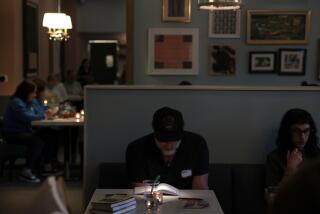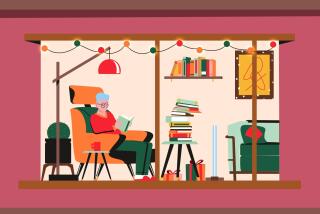‘The Silent History’ turns up the noise on a new kind of e-book
- Share via
For the last 18 months, it was tough for Kevin Moffett to tell people what he was working on. “I would find myself getting out of breath,” he says of his attempts to fully describe the project he was co-authoring.
It’s “The Silent History,” an app that’s a serialized novel, as well as a literary treasure hunt. Like a television show, it took a team of people to create and produce. And it dramatically advances the way digital novels take advantage of the latest bells and whistles available on the iPhone and iPad (sorry, no Android).
“It’s artistically exceptional, and also built around technological innovation,” says Erin Kissane, a consultant who helps publishers with digital content strategies. “These guys have just raised the bar — a lot.”
E-book sales have been increasing at a tremendous rate — 117% in 2011. But the majority of e-books — particularly novels — simply replicate the print experience on-screen. “Mostly, we’re just really happy if they’re easy to read,” Kissane says.
Certain nonfiction books have been able to successfully integrate multimedia. Cookbooks can print a shopping list or set a timer, math textbooks have built-in problems to solve, biographies include videos, photographs and recordings of the real people involved.
Finding appropriate places for those bells and whistles is easy in nonfiction, but “it’s not clear how to include those elements in the DNA of a novel,” says Eli Horowitz, the producer and creator of “The Silent History” and the former publisher of McSweeney’s, Dave Eggers’ independent publishing company.
When you open “The Silent History,” there is a three-part prologue, with visuals and text that set up the story of a present-and-future dystopia in which a mysterious speechlessness epidemic has broken out among a generation of children. You can then buy volumes for $1.99 apiece — an easily digested price tag for people used to purchasing their entertainment a song or video at a time. Purchase the entire 120- episode story and it’s $8.99.
Subscribing to the entire story at once means each day’s content downloads automatically. After the novel’s launch on Monday, I found myself fruitlessly tapping the wedge of screen where the next episode would appear, hoping that somehow Tuesday’s installment would arrive.
A good cliffhanger creates a fevered demand — trying to get their hands on the conclusion of Charles Dickens’ serial novel “Little Dorrit,” American readers rioted on the docks as the shipment arrived.
Dispirited by the humdrum state of e-books, Horowitz committed himself to creating the page turner of the future, devoting a year to developing an app/serial novel that would push beyond what anyone had seen before.
“E-books were unmistakably a lesser form,” he says. “There was not a spirit of excitement about them, among writers or readers.”
After making a list of what iPhones can do, Horowitz developed a story that would suit them. It would need to be delivered in bursts short enough to be read in about 15 minutes, standing in line or waiting for the subway. And it would take advantage of GPS, creating location-specific features.
“The app is really tuned to the story, and the story was created around the possibilities of the device,” Kissane says. “The form and content are closely entangled without being gimmicky. It’s a good novel. It feels like a real book.”
Horowitz structured that book as a multi-voiced oral history. It was written by two co-authors — Moffett, who teaches creative writing at the University of Vermont, and Matthew Derby, an award-winning short fiction writer. Another essential collaborator was Russell Quinn, a top-notch software developer.
Horowitz gave Moffett a two-page story summary and worked with the authors throughout. “We pushed to go big wherever we could,” Horowitz says. They strove for “the most vivid, memorable, surprising, interesting mix.”
“We had models — serialized TV shows like ‘The Wire’ and ‘Deadwood,’” Moffett notes, “with large outsized figures who you know but continue to change.”
Like a television show runner, Horowitz oversaw it all, mapping out story arcs, discussing emotional beats and tracking factual strands. When they were finished, they’d written a 160,000-word piece, the equivalent of a 500-page novel.
Another innovation of “The Silent History” is the additional narratives that complement the story, contributed by other writers. Called Field Reports, they appear as pins on a dynamic, zoomable worldwide map inside the app; so far, there are 13 in Los Angeles, 29 in New York City, 25 in Australia and one in Antarctica.
The only way to read a Field Report is to visit its location, with iPhone or iPad in hand.
At the top of a stair street in Silver Lake, my iPhone’s screen began pulsing green: I could unlock a Field Report by writer Michael Andreasen. Futuristically dated 2015, it was about a man who had built a treehouse for his silent son; their yard had a door onto the steps. I started down the stairs and turned to look at the first door I found; there, up above, was a treehouse.
The story was fictional, but for a moment it felt as if reading the words on my screen had made the treehouse materialize. That actually gave me chills, an unexpected bonus in what was already a fun, run-around-town treasure hunt.
The Field Reports are ever-expanding; within the app, readers can apply to contribute their own. “I have no idea how many submissions I’ll get. That’s one of the big mysteries,” Horowitz says. But by the end of the first day he’d received 50 requests, a fourth of the 200 Field Reports they had started with.
Those writers are willing to be part of the project for no compensation. The official budget for “The Silent History” was shoestring — less than $6,000 — which clearly excludes costs like salaries. Horowitz spent a year conceptualizing, mapping out, developing and adapting the story as the others worked on it in between day jobs. He and Quinn formed a company with Chris Ying, editor of the successful new food magazine Lucky Peach, to manage the unconventional business side of “The Silent History.”
“Publishers are looking for a template they can replicate,” Kissane says. “‘The Silent History’ is not that at all.”
It is, however, a landmark project that illuminates a possible future for e-book novels. Traditional publishers are watching but don’t currently have systems in place to put such a creative project into production. The first moves, like “The Silent History,” may have to come from more nimble independents.
Horowitz admits that he might try similarly ambitious e-book projects “after this one,” but they probably won’t be exactly like “The Silent History.” It was built for specific devices that work in this moment, geared toward how we read right now. The technology may change; modes of reading may evolve in ways we can’t anticipate.
“It’s not like I’m saying the future is standing on a dirty street corner reading 1,000 words a day,” Horowitz says. “The future is experimentation, innovation and excitement.”
More to Read
Sign up for our Book Club newsletter
Get the latest news, events and more from the Los Angeles Times Book Club, and help us get L.A. reading and talking.
You may occasionally receive promotional content from the Los Angeles Times.









